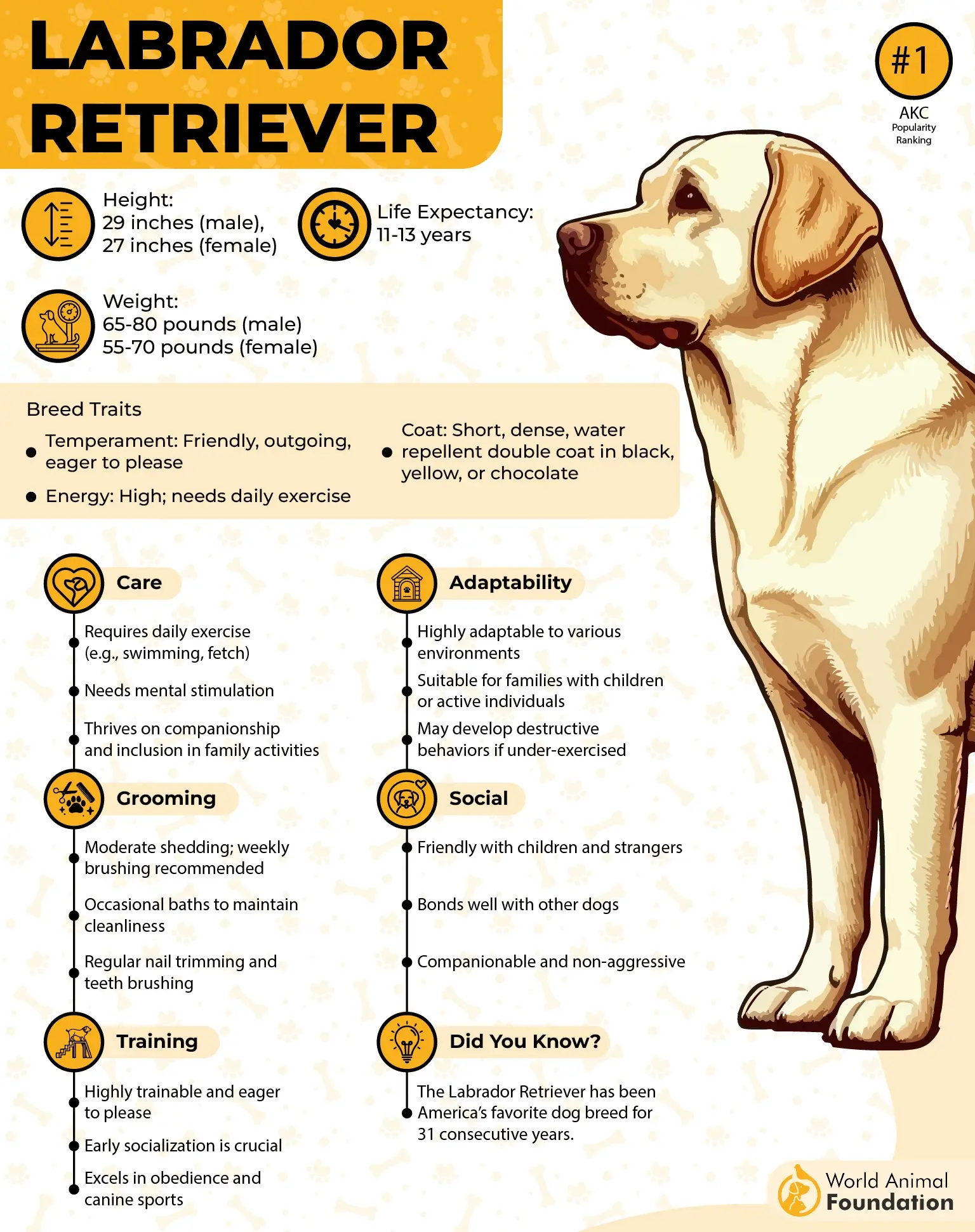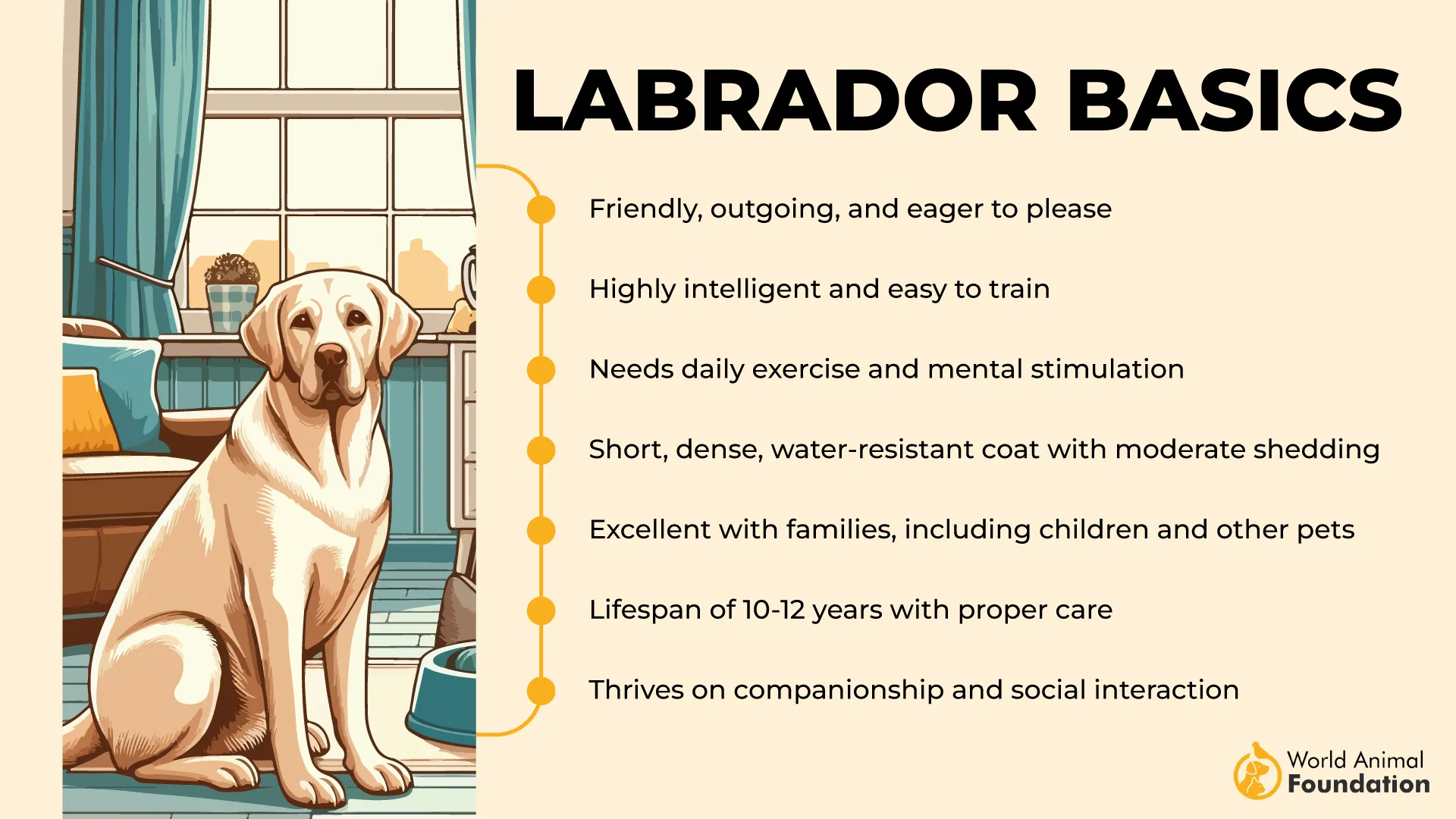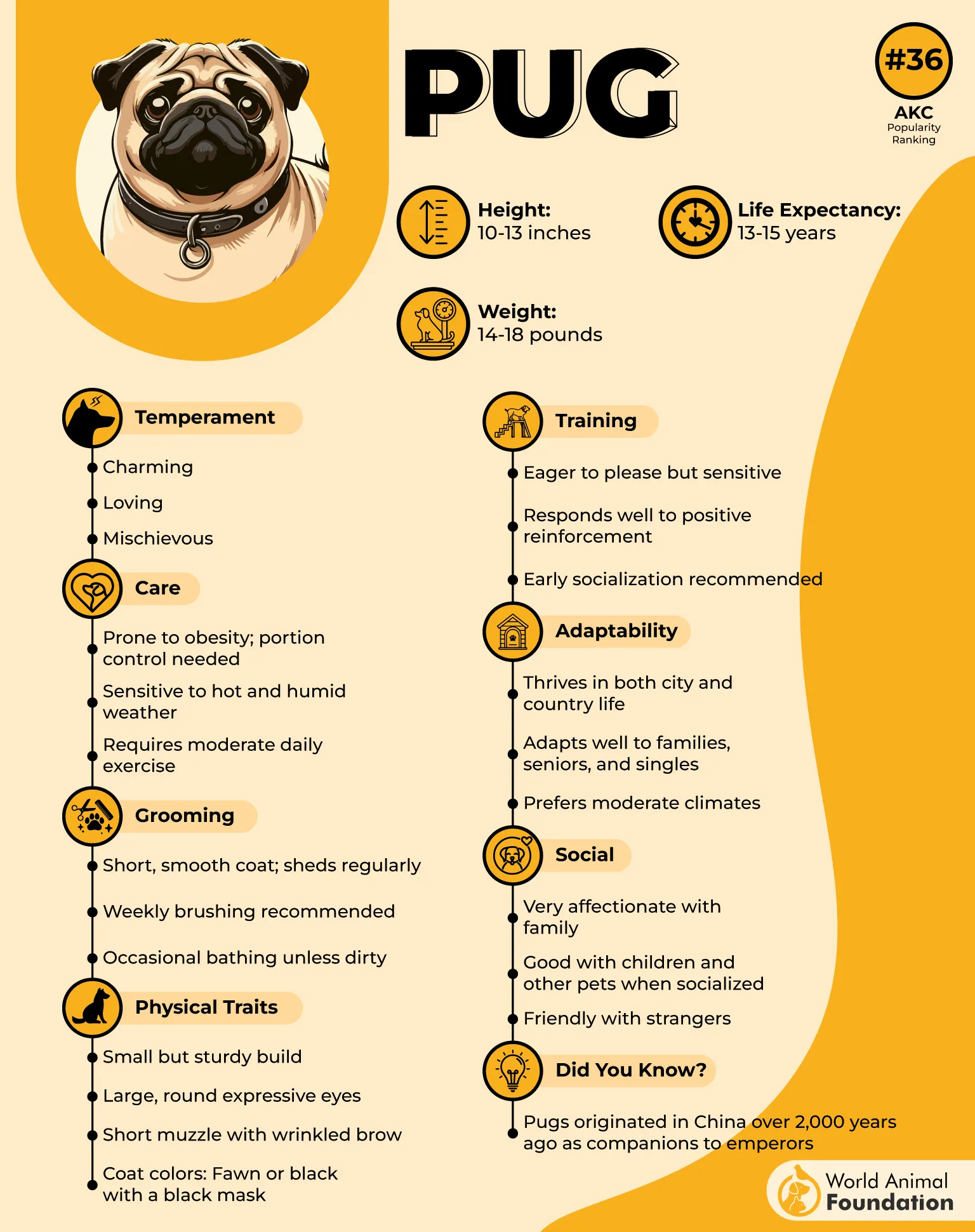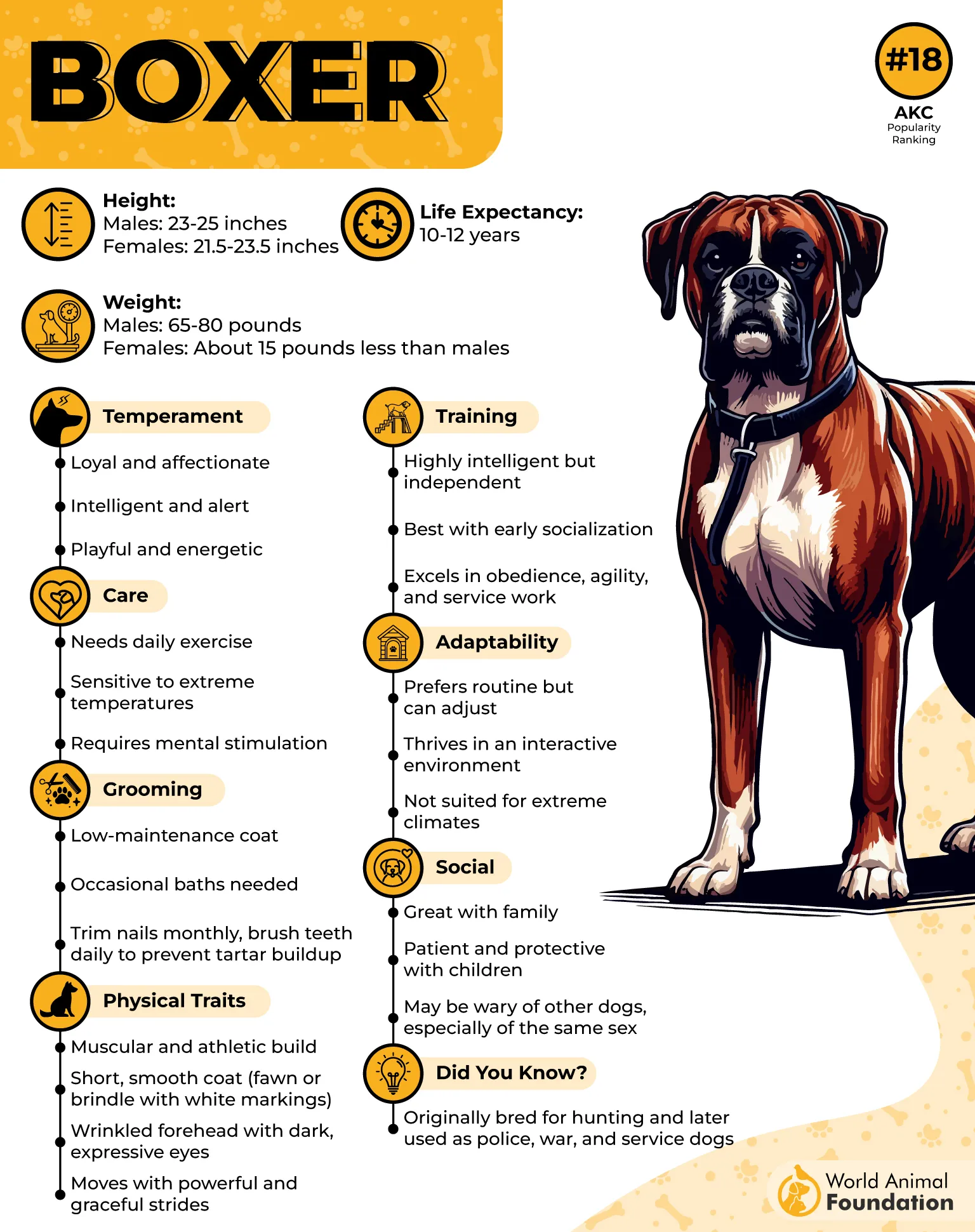Food motivation is a dog owner’s secret weapon. When a dog truly loves to eat, training becomes ten times easier. No need for fancy methods or dog psychology degrees—just some tasty treats and a willing pup.
The seven dog breeds we’re covering today aren’t just family-friendly; they’re walking stomachs with fur. These food-driven dogs will sit, stay, roll over, and probably even do your taxes if there’s a treat involved. This natural food drive makes them perfect for families, especially those with kids or first-time dog owners still figuring out training basics.
Beyond training perks, these food-loving breeds tend to bond strongly with whoever feeds them (hint: that could be you!). They’re attentive, eager to please, and always ready for mealtime.
If you’re looking for a family companion that’s both trainable and food-obsessed, you’re about to discover your perfect match.
Food-Motivated Family Dog Breeds
1. Labrador Retriever

The Labrador Retriever is a beloved family companion across the U.S. With their muscular build, wide nose, and strong tails, Labs are built for action. These medium-to-large sporting dogs are famously friendly and active, thriving in homes where they can burn off energy and feel like part of the pack.
Train Early, Train Often
Labs are highly intelligent and eager to please, which is why they excel in obedience training. Many go on to serve as search-and-rescue dogs, therapy animals, or guide dogs for those with disabilities.
Puppy training and early socialization are crucial, not just to help them get along with other dogs, but also to curb those classic puppy pitfalls like chewing, biting, and scavenging. Be patient but firm; these puppy dog eyes are hard to resist, but consistency is key.

Mind the Mealtime
Labradors have big hearts—and even bigger appetites. As one of the more food-obsessed dog breeds, they’re notorious for gobbling down meals at lightning speed.
Feeding them twice a day and using a slow-feeder bowl can help regulate intake and avoid stomach upset. Keeping your Lab at a healthy weight is important, especially since their love for snacks can lead to unwanted pounds.
Perfect for Families Big and Small
With their gentle nature, loyalty, and trainable temperament, Labs are incredibly versatile dogs. They adapt well to active family life, enjoy being around kids, and love spending time with their humans.

Did you know? Labrador Retrievers were made for the water; they originally helped fishermen on the job, as per the source of The Labrador Retriever Club.
2. Pug

The Pug has been melting hearts for over 2,000 years, starting in ancient China and later capturing the favor of royals across the globe. With their unmistakable wrinkled faces, curly tails, and signature snorts, these dogs might be small in size, but they’re bursting with charm.
A Healthy Appetite (and Then Some)
If there’s one thing Pugs are famous for—aside from their expressive eyes—it’s their food obsession. While this makes them highly trainable with positive reinforcement, it also means their meals (and treats!) need to be carefully managed.

Obesity is a real concern for the breed and can lead to breathing issues and an increased risk of heatstroke. To support a healthy weight, feed adult Pugs two to three small meals a day, and always monitor your dog’s appetite. For puppies, even more frequent meals may be needed to prevent low blood sugar.
Nutrition and Allergies
Managing your dog’s diet is especially important with this breed. Some Pugs are prone to food allergies, which can lead to itchy skin or digestive discomfort. Your vet might recommend a feeding trial to help pinpoint the trigger and suggest the right food with limited ingredients or novel proteins, as PetMD suggested.
Big Love in a Small Package
Like most dogs, Pugs thrive on companionship and affection. They’re known to be gentle, playful, and extremely people-oriented. Their size and temperament make them ideal for apartments or homes where snuggles are frequent and walks are relaxed. Just be prepared for a few wheezes and snores along the way—it’s all part of their charm.
3. Boxer

Boxers made their way from Germany to the U.S. in the 1930s, originally prized for their hunting skills and stamina. Today, they’re celebrated for their strength, agility, and lovable nature.
Whether sprinting across the yard or leaping in excitement, these dogs are full of playful energy, making them an ideal furry friend for active pet owners.
Feeding for Health and Energy
This energetic breed needs fuel to match its high activity levels, but managing your dog’s weight is crucial—especially to protect their joints. Adult Boxers thrive on two meals a day, spaced about 12 hours apart.
For fast eaters (a trait common in food-obsessed breeds), a slow-feeder bowl is a smart way to reduce the risk of bloating and GDV. Just remember: avoid raised bowls, as they can increase that risk.

Boxer puppies, on the other hand, require three to four smaller meals daily to support their growth. As they mature, keeping their weight in check and maintaining a consistent feeding schedule will go a long way in supporting their long-term health.
An Athlete by Nature
Boxers aren’t just active—they’re naturals when it comes to dog sports. They shine in rally, agility, lure coursing, and more. These workouts aren’t just great for their bodies—they also provide essential mental stimulation to prevent boredom-driven behavior.
Give your Boxer at least 30 minutes to two hours of daily exercise, and you’ll have a happy, well-balanced companion who’s always up for a challenge.
4. Cocker Spaniel
With their soulful eyes, silky ears, and cheerful spirit, Cocker Spaniels—formally known as American Cocker Spaniels—have long held a place in the hearts of pet owners around the world.
They bred for hunting, but these affectionate dogs are just as happy exploring the great outdoors as they are curled up beside you on the couch. Their smaller size and loving nature make them an ideal furry friend for both seasoned and first-time dog parents.
Feeding With Care
Because they aim to please and are often highly food-motivated, this breed can be prone to food obsession. While that trait helps during training, it can lead to overeating. A balanced dog’s diet with two well-portioned meals a day—morning and evening—is typically best.
Puppies, however, may need three to four meals daily during growth stages. Cocker Spaniels that are primarily family companions often require extra attention to portion control to maintain a healthy weight and prevent obesity.
And don’t forget the grooming tip—due to their long, flowy coats, food can easily get caught in their fur during meals. A quick post-meal clean-up helps prevent matting and keeps their coat looking its best.
Gentle, Loyal, and Eager to Please
AKC notes that these dogs are not just about looks—they’re bright, social, and thrive in environments where they feel included. Whether as a loyal sidekick for a solo owner or a playful buddy in a busy household, the American Cocker Spaniel offers endless affection, enthusiasm, and charm.
5. Golden Retriever
Golden Retrievers are consistently one of the most popular dog breeds in the U.S.—and it’s easy to see why.
With their loyal nature, eager-to-please attitude, and gentle temperament, “Goldens” make ideal companions for families, singles, and other dogs alike. They’re known for being affectionate with children and adaptable when well-socialized from a young age.
Feeding Tips for a Food-Loving Breed
Golden Retrievers are famously enthusiastic eaters, making them one of those food-obsessed dog breeds that pet parents need to monitor closely. While their love of treats makes training a breeze, their puppy dog eyes can be dangerously convincing at mealtime.
To help manage portions and promote a healthy weight, feed adult Goldens two measured meals daily (morning and evening). Puppies require more frequent feedings—three to four small meals per day.
To curb rapid eating, which can lead to stomach upset or vomiting, consider using a slow-feeder bowl or an interactive food puzzle. These tools not only slow them down but also provide mental stimulation—something this intelligent breed thrives on.
Smart, Social, and Always Ready to Learn
Training your Golden with positive reinforcement and consistency sets the foundation for a well-behaved, confident dog. Socializing your pup early helps them grow into the friendly, dependable companion the breed is known for—one who’s ready to greet the world with a wagging tail and a big heart.
6. French Bulldog
The French Bulldog is a small but mighty bundle of joy—quirky, playful, and always ready for mischief. Their pint-sized frame and affectionate nature make them popular with families, especially those in apartments or smaller spaces. Frenchies love being around people and can be great furry friends for kids, with proper supervision, of course.
Training the Fun-Loving Frenchie
When it comes to training, French Bulldogs thrive on games, silliness, and—most importantly—snacks. Their food obsession can work in your favor; use high-value treats and lots of praise to keep them engaged.
But be warned: if training becomes boring or too repetitive, Frenchies might suddenly have better things to do (like napping in sunbeams).
Feeding Tips for All Life Stages
Feed adult French Bulldogs twice daily and puppies three to four times a day. It’s crucial to offer a high-quality, life–stage–appropriate diet from puppyhood to their senior years. A balanced dog’s diet helps support their unique build and energetic bursts.
Watch dog’s appetite closely, though—Frenchies can gain weight quickly, and pet owners may need to adjust portion sizes or switch to a calorie-restricted plan if pounds start creeping on.
7. Cavalier King Charles Spaniel
The Cavalier King Charles Spaniel is the epitome of a loving, loyal companion. Known for their gentle nature and affectionate demeanor, these dogs make perfect pets for first-time pet owners or those seeking a calm, sweet-natured addition to the family.
Once adored by British royalty in the 17th century, they’re still popular today for their easygoing personality and devotion to their humans.
Feeding for All Stages
Like all dogs, feeding your Cavalier King Charles Spaniel properly is essential for their health. As puppies, they require a specialized puppy dog food designed to support their growth and development.
Once they reach adulthood, a high-quality, age-appropriate diet is key—aim for food labeled for adult dogs. For seniors over 7-8 years old, consult your vet about transitioning to senior food that helps support aging joints and lean muscle mass.
Maintaining a Healthy Weight
Because Cavaliers are prone to orthopedic issues, keeping their dogs’ weight under control is vital. You might want to consider a low-fat or low-calorie diet for adult and senior dogs. A lean body helps them avoid unnecessary strain on their joints, which is crucial for their long-term health.
Conclusion
Finding the right food-motivated dog for your family isn’t just about picking the cutest face—it’s about matching your lifestyle with a breed that thrives on treats and training. Whether it’s the ever-hungry Labrador, the food-obsessed Pug, or the treat-loving Golden Retriever, these seven breeds bring both appetites and affection to your home.
Their food motivation isn’t just about empty stomachs; it’s the key to easier training, stronger bonds, and lots of kitchen-centered family memories. Remember that managing their love for food is part of responsible ownership—proper portions, healthy treats, and regular exercise will keep these food-motivated friends at their best.
With patience, consistency, and plenty of healthy treats, you’ll find these breeds make fantastic family companions who are always ready to work, play, and love—especially when there’s food involved. The perfect family dog might just be the one waiting eagerly for their next treat!


